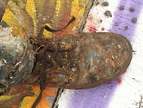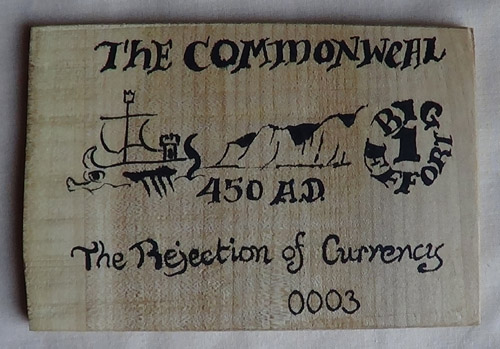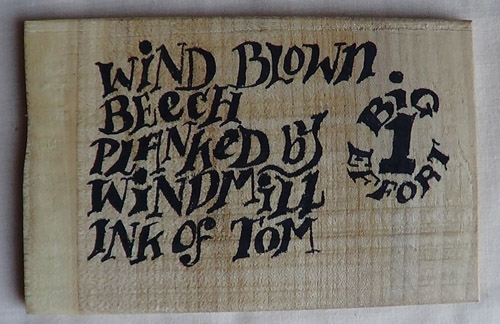 (About Tom)
(About Tom)
(links)
(Contact)

 (About Tom) (About Tom)
(links) (Contact) |
|
DIY Currency, 12 year odyssey. "Obviously the creation of sterling is immoral as most people understand it, it doesn't do what society wants it to, and sterling is certain to fail soon, so the race is on to find a new financial currency before this one collapses ruinously". Steve Baker MP, junior treasury minister 2017. I think I'd enjoy being the mint. Can I beat facebook, the Bank of England and the IMF and get my currency up and exchanging first? Tom Cousins £5er, 2020
You can accept a 'Tom Cousins £5' from me for goods or services, possibly even slightly unpleasent plastic £5 notes. You can then try and spend it with somebody else or return to me and I will accept it back in return for half an hour of my artistic labour. When deciding whether to accept my £5er, you should ask yourself do I like this object as much as £5 sterling? Will someone else value this as much as £5 sterling? How likely is Tom to become as famous as Banksy and what would it then be worth? Can I or someone else I know make use of Tom's artistic labour in the future - obviously this will be much more likely if you live in the Forest of Dean. I printed £300 worth in Feb 2020 as an experiment. Its silk screen printed slivers of mixed wood (this one is chestnut), approx 80mm x 68mm x 3mm. If my 'Tom Cousins £5ers' are casually accepted as currency I shall make a second release in my winter slack months of 2021. Why wooden money? Apart from I live in the Forest, I want to make money real before we all have to transact with an app. Pastic sterling might take 400 years to degrade, but you won't be able to use it in 15 years time. Whereas I have no pension, my currency is a relatively safe longer term risk and at least you'll be able to start a fire with it if not. Coleford cash, 2019 Local currencies have worked well in small towns of Canada and Australia, where isolated communities have exchanged so much tax unrecognised currency that tax revenue has dried up. You could look at it as anti social tax dodging, or as an effective free way of investing in the rural economy and making it immune to the failings, whims and profiteering of global banking.
In 2019 I proposed to the Coleford Town Council Regeneration committee that I printed Coleford Cash, it was to be �2.50 or �5 denomination silk screen printed onto credit card slivers of wood. As I discussed it with shop keepers, tradesmen and town councilors it went through various mutations. The positives I was promoting was Coleford branding, encouraging local residents to shop in town, sales to tourists, and suggesting it be seen as a discount voucher. I would like to have given �10 to every resident, �80,000 total distributed with council tax bills. However I tinkered with the values and distributions of the system, while shops might have experienced increased sales, it was hard to see how some of them might avoid the position of being left with a load of wood they coudn't spend, so it would end up as a tax on shop keepers. And shop keepers in Coleford genuinely can't afford that. While historically local currencies have capitalised on tax evasion, I notice that the Bristol pound is mostly a mobile phone digital transaction currency. It appears to be gaining traction because it doesn't need to charge bank charges. In other words it is capitalising on the expenses charged by banks. You can buy Bristol pounds cheap and when you spend them the shop still makes a profit, and the banks are the only losers. Bristol pounds are garunteed by the Bristol Credit Union and are tax deductable so its not a tax dodge. Its a safe ethical and popularity multi win situation. To me this says, the successful local currency is going to be digital, it won't involve me being the mint, and it is therefore someone elses enterprise/responsibility since I don't even use a mobile phone and have no idea where to start. 1 Big Effort 2017  
This '1 Big Effort' is made of wind blown beech, planked on Robin Larkhams mobile Cretan windmill, painted with my own ink made from chimney soot. Each 1 Big Effort takes a big effort to make, so I value it at a day of work. This currency is not invented by tapping a computer 'enter' key, it took as long to craft as I claim it is worth. I shall be releasing a second round of quantitive easing from Robin's windmill at the Green Gathering Festival and Sol Fest 2017. 450AD relates to a globally unique event in British history. When the Romans left taking all their money with them no one bothered to make any more money for another 300 years. It is the only known rejection of currency once it has been established. What will happen when London sucks all of the money out of the UK and sends it overseas again and there's none left? Will we live in poverty, make our own money or return to barter? So as to initiate wealth redistribution at the same time as introducing my new currency, I asked people to state their status and offered my Big Efforts priced at �320 for bankers and overseas asset holders, �90 for wage slaves, and �10 for landless peasants. I sold a lot to landless peasants, and had a few pinched. From a personal finances point of view it didn't quite work so although I really liked them from every other point of view, I had to discontinue minting and distribution. Robin's windmill www.windcraft.org.uk, Bank of Ideas 2011 I went to the Occupy London's Bank of Ideas, Dec 2011, a squatted UBS bank. It troubled me that there was no cash in the bank. I'd liked to have organised a community money making project, making hand made souvenir/publicity notes but I didn't have the time to see it through. While their though it was said it'd be good to make a new currency, so I designed a note and left it to circulate
1 Eco 2008 Down at my local 'Transitions' meeting (2008) some people were discussing making a local currency, similar to the Totnes pound http://totnes.transitionnetwork.org/totnespound/home So I set myself a design challenge, how do you make a lot of money quickly, which is also hard to copy?
The note I designed uses A4 recycled paper, the size of a tall credit card so it fits in a wallet without a fold, fitting 12 notes in the A4 sheet. It has 3 or more painted stripes down one side of the note. Two of the colour strips are emulsion paint which dries a different colour than when wet and is therefore difficult to copy, and 1 stripe in gloss paint. Each colour is made up of 4 or 5 standard colours, making trying to match them very difficult, and ensuring it is quite expensive as any fraudster would need a lot of tins of paint. The note can then be easily verified by holding against another note or a test strip, any slight colour variation, or surface texture (gloss and emulsion paint have a different surface sheen from even acrylic paint) should then be easy to spot. (As a mural painter I could use left over sludge colours). The central currency title, denomination, and date would be a lino or woodcut print. The advantages being that the print has a 3D texture quite different from any computer print outs, immediately identifiable by touch, and not many people would have the tools or the skill to copy the design in wood or lino. The printer could load three unusual colours on the roller so as to get a rainbow print, again making it more expensive for any casual fraudster as they would need to buy an entire print colour range of inks. (Again I have old leftovers in my cupboard). I'm sad to say that my local Transitions isn't quite ready for its own currency after all, so my minting days will have to wait, but I'm ready for when it is. http://www.transitionforest.org.uk/forum/index.php One day I shall be the mint.
Respect to Jean Michael Basquiat.
|
|
|
 |
 |
 |
 |
 |